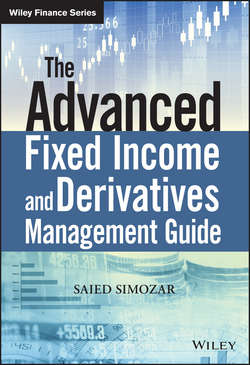Читать книгу The Advanced Fixed Income and Derivatives Management Guide - Saied Simozar - Страница 12
На сайте Литреса книга снята с продажи.
Chapter 1
Review of Market Analytics
1.1 BOND VALUATION
ОглавлениеIf interest rates fall, the value of an existing bond increases since investors will pay a premium price for a bond that has a higher coupon payment than a newly issued bond with a lower coupon. This brings us to the simplest and most fundamental of all pricing formulas in the fixed income market, namely the present value of a bond, defined with a principal amount of 100 as
1.1
where p is the present value of the bond, ym is the market yield or effective interest rate of the bond, m is the frequency of coupon payment (if the bond pays semi-annual interest, then m = 2, if it pays quarterly, then m = 4), c is the periodic coupon payment, and n is the number of interest payments. It can be easily shown that if the present value of the bond on issue date is equal to 100, then the following relationship holds:
1.2
In our prior example, the semi-annual coupon payment per 100 of principal would be 3.5. Inserting this value for c, and using m = 2, leads to a yield of 0.07 or 7 %. Thus, on issue date, the yield of a bond priced at 100 (par) is equal to the annual coupon payment of the bond per 100 principal amount divided by 100. At all other times, the price/yield function of a bond is a little more complicated.
Nearly all bonds in the market are traded on the basis of what is known as the clean price. The clean price does not include the amount of interest that has been accrued but not paid to the bond holder. Accrued interest is the pro rata share of the next coupon payment that is due the seller at the time of the trade settlement. In our previous example, if after 3 months the bond holder sells his bonds, then the buyer has to pay half of the next coupon payment to the seller for holding the bonds for half the period of coupon payment.
Different bond markets have different conventions on how the accrued interest is calculated. Accrued interest for US treasuries is calculated on an actual/actual basis with semi-annual payments. For example, a bond that pays coupon on February 15 and August 15, if it is purchased on March 15 of a non-leap year, the amount of accrued interest would be calculated by the ratio 28/181 multiplied by the amount of semi-annual coupon payment. This ratio is the number of days between February 15 and March 15 (28) divided by the number of days in the period between February 15 and August 15 (181).
Corporate or agency bond markets use the 30/360 convention, implying that a month is 30 days and a year is 360. In the above example, the number of days between February 15 and March 15 would be 30 and the number of days from February 15 to August 15 would be 180.
If we denote the fractional accrual period by x, our present value formula will change to
1.3
In this equation, 1 − x is the fractional period to the next cash flow or coupon payment. We can convert it to the fraction of a year by multiplying it by m. Thus,
1.4
If we denote the cash flow at time ti by ci and the invoice price by pm, we can simplify the above equation to
1.5
Equation (1.5) is a generalization of (1.4) and allows for cash flows to be different. It can be used for bonds with step coupons or sinking or capitalizing principals. As can be seen, the market yield of a security depends on the accrual frequency. For example, German government bonds (Bunds) accrue on an annual basis while US treasuries pay coupon semi-annually. If you buy 100 units of a Bund at a yield of 6 %, after 1 year the value of principal and interest will be 106. For US treasuries with the same yield, there is a semi-annual interest payment of 3 %, which if reinvested at the same rate will result in 106.09. The effective yield of the US treasury is 6.09 %. We therefore need to analyze all bonds on the same footing to be able to make fair comparisons.
